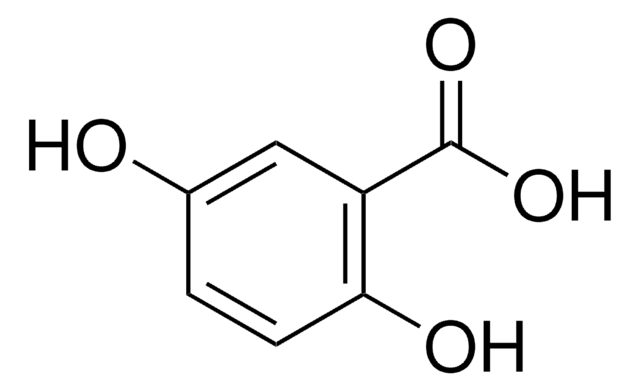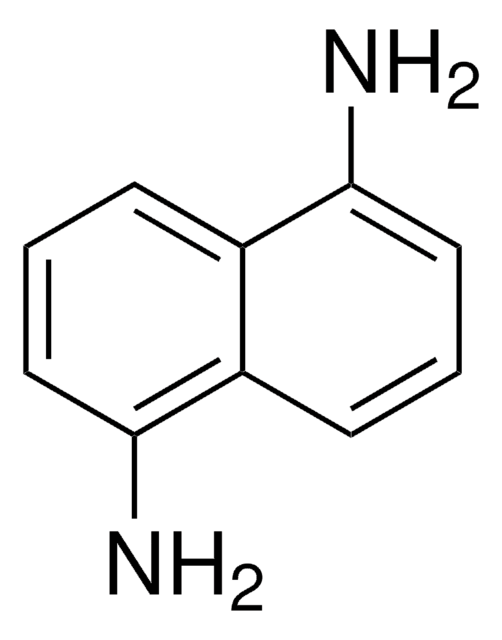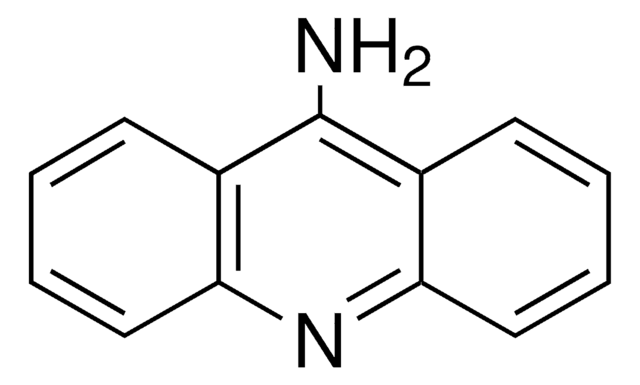50862
Super-DHB
suitable for matrix substance for MALDI-MS, ≥99.0%
Sign Into View Organizational & Contract Pricing
All Photos(2)
About This Item
Recommended Products
Quality Level
Assay
≥99.0% (sum of DHB and 2-hydroxy-5-methoxybenzoic acid, HPLC)
≥99.0%
analyte functional class(es)
polymers
analyte chemical class(es)
glycans, peptides, proteins
technique(s)
MALDI-MS: suitable
solubility
methanol: 1%, clear
cation traces
Ca: ≤5 mg/kg
Cd: ≤5 mg/kg
Co: ≤5 mg/kg
Cr: ≤5 mg/kg
Cu: ≤5 mg/kg
Fe: ≤5 mg/kg
K: ≤5 mg/kg
Li: ≤5 mg/kg
Mg: ≤5 mg/kg
Mn: ≤5 mg/kg
Na: ≤5 mg/kg
Ni: ≤5 mg/kg
Pb: ≤5 mg/kg
Zn: ≤5 mg/kg
suitability
suitable for matrix substance for MALDI-MS
Related Categories
General description
The “super-DHB” matrix consists of a 9:1 (w/w) mixture of 2,5-DHB and 2-hydroxy-5-methoxybenzoic acid, respectively, since this ratio was found to be the most effective. The beneficial effect of the 2-hydroxy- 5-methoxybenzoic acid additive is attributed to a disorder in the 2,5-DHB crystal lattice resulting in enhanced ion desorption (i.e. ‘softer′ desorption) and reduced internal energy, which in turn results in reduced metastable fragmentation. An increase in sensitivity of up to 2 to 3-fold has been reported for a standard dextran mixture with concomitant enhanced resolution attributed to reduced metastable ion formation. The super-DHB matrix has also been reported to generate enhanced signals from tryptic glycopeptides. The use of super-DHB matrix is reported to reduce the presence of matrix background ions and result in glycan signals exhibiting better signal to noise ratios and higher resolution in the mass spectrum.
Application
- Glycan and Protein Analysis of Glycoengineered Bacterial E. coli Vaccines by MALDI-in-Source Decay FT-ICR Mass Spectrometry: This study demonstrates the application of Super-DHB as a matrix in advanced mass spectrometry for the detailed characterization of glycoengineered vaccines, essential for researchers in pharmaceuticals and life science manufacturing (Nicolardi et al., 2022).
- An Improved Method for Rapid Detection of Mycobacterium abscessus Complex Based on Species-Specific Lipid Fingerprint by Routine MALDI-TOF: Highlights the use of Super-DHB in enhancing the lipid fingerprinting capabilities of MALDI-TOF mass spectrometry, critical for rapid microbial identification in medical microbiology and pharmaceutical research (Jia Khor et al., 2021).
- Discrimination of bovine milk from non-dairy milk by lipids fingerprinting using routine matrix-assisted laser desorption ionization mass spectrometry: Illustrates the role of Super-DHB in differentiating dairy and non-dairy milks based on lipid profiles using MALDI-MS, vital for food scientists and chemists in quality control and food safety (England et al., 2020).
Packaging
Bottomless glass bottle. Contents are inside inserted fused cone.
Analysis Note
9:1 mixture of DHB and 2-hydroxy-5-methoxybenzoic acid
related product
Product No.
Description
Pricing
Signal Word
Warning
Hazard Statements
Precautionary Statements
Hazard Classifications
Acute Tox. 4 Oral
Storage Class Code
11 - Combustible Solids
WGK
WGK 3
Flash Point(F)
Not applicable
Flash Point(C)
Not applicable
Personal Protective Equipment
dust mask type N95 (US), Eyeshields, Gloves
Choose from one of the most recent versions:
Already Own This Product?
Find documentation for the products that you have recently purchased in the Document Library.
S Can Akerman et al.
Journal of Alzheimer's disease : JAD, 69(2), 463-478 (2019-04-23)
There is increasing evidence suggesting that amyloidogenic proteins might form deposits in non-neuronal tissues in neurodegenerative disorders such as Alzheimer's or Parkinson's diseases. However, the detection of these aggregation-prone proteins within the human skin has been controversial. Using immunohistochemistry (IHC)
Sonia Rebollo-Ramirez et al.
Chemical research in toxicology, 31(8), 688-696 (2018-06-28)
Antimicrobial resistance is a major threat the world is currently facing. Development of new antibiotics and the assessment of their toxicity represent important challenges. Current methods for addressing antibiotic toxicity rely on measuring mitochondrial damage using ATP and/or membrane potential
Jacob L Bouchard et al.
Molecules (Basel, Switzerland), 24(12) (2019-06-19)
Amyloid-β oligomers (AβOs) self-assemble into polymorphic species with diverse biological activities that are implicated causally to Alzheimer's disease (AD). Synaptotoxicity of AβO species is dependent on their quaternary structure, however, low-abundance and environmental sensitivity of AβOs in vivo have impeded
Our team of scientists has experience in all areas of research including Life Science, Material Science, Chemical Synthesis, Chromatography, Analytical and many others.
Contact Technical Service


![trans-2-[3-(4-tert-Butylphenyl)-2-methyl-2-propenylidene]malononitrile matrix substance for MALDI-MS, ≥99.0% (HPLC)](/deepweb/assets/sigmaaldrich/product/structures/249/587/f8021369-f65a-413d-887d-3c8a4d2a248f/640/f8021369-f65a-413d-887d-3c8a4d2a248f.png)




